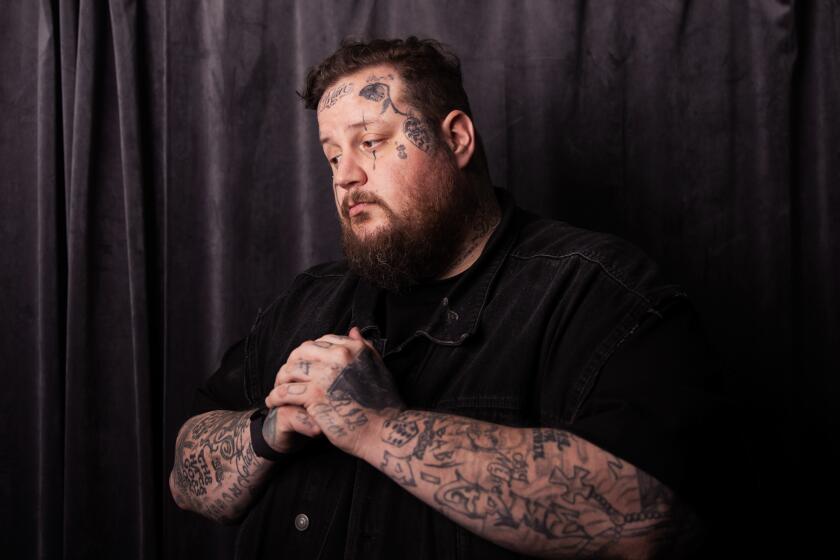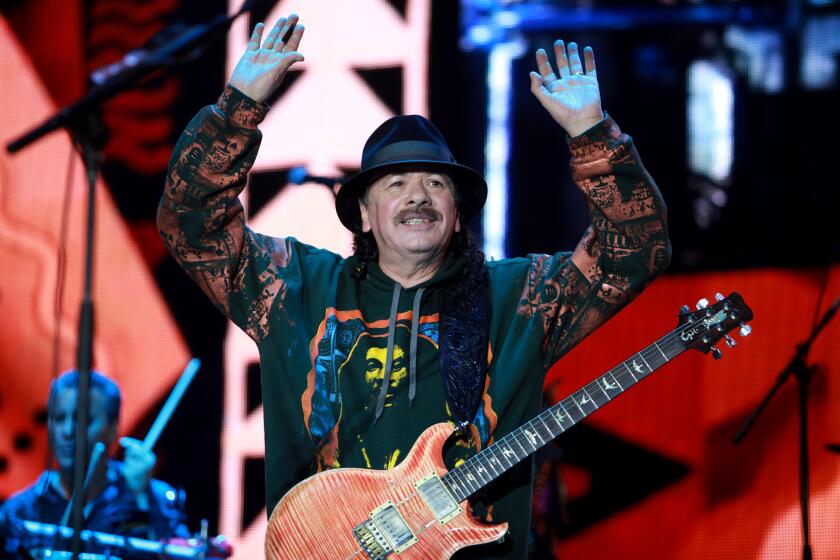First there was a documentary, now a TV series explores Wu-Tang Clan’s wild history
- Share via
NEW YORK CITY — If someone had told rapper Raekwon the Chef back in the ’90s that his group Wu-Tang Clan would one day have a Staten Island street named after it, or be the subject of an Emmy-nominated documentary, or the focus of a 10-part dramatic series, “I would have looked at them like they were [completely] crazy.”
“It would have been like saying you were going to see a black president,” he said.
And yet, here we are. The street was dedicated in May; director Sacha Jenkins’ doc, “Of Mics and Men,” is poised for that Emmy, and on Wednesday, “Wu-Tang: An American Saga” debuts on Hulu.
A very-close-to-reality 10-part series, it was co-created/written by Alex Tse (“Watchmen,” “SuperFly”) and RZA, Wu-Tang’s guiding light and engineer of the current surge in Wu energy. “It’s no accident,” RZA said at the Staten Island set where the production spent six months. “It’s a six-year plan. It was a five-year plan. But it took six years.”
It’s been a tumultuous history. The group’s debut, “Enter the Wu-Tang (36 Chambers),” released in 1993, was a “failure,” RZA said; internal strife, Wu-Tang’s seemingly constant companion, has taken its toll throughout the years. “And I realized I had to be the torchbearer,” he said. “I thought about what would be the best way to express the Wu, the best way for story to exist and the best partners, before I chose Sacha to make the doc.”
“Wu-Tang: An American Saga,” which was developed at Imagine with Brian Grazer, will deliver the most street-level of origin stories into the American living room, the tale of nine rappers who came of age during the crack epidemic of the ’90s, who experienced, and sometimes engaged in, drug dealing and gun violence. Is it all true?
“It’s not a simple question,” said Tse. “For the most part, it’s a truthful telling of their story — there are certain things that really happened, things where a version of it really happened, and things that got moved around the timelines to work thematically.
“It’s not ‘Inglourious Basterds,’” he added, referring to Quentin Tarantino’s alternative history version of World War II. “The starting point and destination are truthful. We’re not changing the end results. But in making the drive more interesting we had to make some lefts and rights.”
But their mystique has always radiated beyond the range of ordinary fandom. What is all the romance about? Togetherness, for one thing: The members were all capable of maintaining solo careers, and did; but despite their differences, they found strength in unity.
All operated under pseudonyms: RZA, GZA, Ghostface Killah, Master Killa, U-God, Method Man, Raekwon, Inspector Deck and the late Ol’ Dirty Bastard. (Cappadonna joined later). No one knew their secret identities. They were like the superheroes of rap. The hip-hop Avengers.
“That’s exactly how we were talking about them,” said Beatrice Springborn, head of original programming at Hulu. Springborn, who has been closely associated with bringing such women-centric programming as “The Handmaid’s Tale,” “The Mindy Project” and “Little Fires Everywhere” to Hulu, said there were a number of reasons the project fit, beyond the mystique and the romance.
“We’ve got a group of executives who are all huge hip-hop fans,” she said with a laugh. “But I’m also fascinated how men come of age and how mothers help men learn to be men — and you see that in this story. Also, how young men help each other learn to become men, and help each other grow up, without fathers in some cases.”
It might be a stretch to call the relationships on “An American Saga” paternal, but there was certainly guidance being given — the actors not only portray real, live people who are involved in the production but who might actually be on the set. In fact, when he wants an employee performance review, actor Ashton Sanders goes up to “the boss” and asks, “Do I suck?”
Sanders (“Moonlight”) stars as Bobby Diggs — aka RZA — an aspiring rapper and sometimes small-scale drug dealer who with his contemporaries in the Park Hill and Stapleton projects of Staten Island create one of the most influential rap groups in history. Siddiq Saunderson is Dennis “D-Love,” who’ll be Ghostface Killah. Shameik Moore plays Sha, who will become Raekwon — who, between opening a men’s grooming lounge and boutique in Toronto (611 Purple Factory) and getting into the wine business (Licataa, a sparkling red), was trying to help Moore “be the best me he could be.”
Sanders, however, has had his (literal) role model on set throughout. He said his process was more about absorption than scrutiny.
“I’m not having a casual conversation with him and taking notes,” he said of RZA. “It’s more of a learned, natural thing. The more time I spend with him the more I can pick up on his speech patterns, the nuances, the way he moves. RZA is RZA, but he’s definitely grown since he was 16, 17, so I had to do a lot of research on who RZA was then. He was younger and much more of a savage, you know what I’m saying?”
RZA, who has acted, written, directed, produced and scored films and plays a zombie UPS driver in Jim Jarmusch’s latest (“The Dead Don’t Die”), said he has no trouble watching himself be played on the set. “What gets me is post-production. Memories are triggered, nuances are happening, sometimes anxiety.”
A scene in Episode 4 features the young RZA, then going by “Bobby Dynamite,” getting booed during a battle of the MCs. “I’ve been booed maybe twice in my life,” he said. “And I don’t remember twice — some of my friends say twice. Method Man says I got booed at the Park Villa, but I don’t remember. The audience wasn’t feeling it; I thought I was cool [laughs] but I want to show that. I felt bad for the character. My wife felt bad for the character.”
“What’s always struck me about RZA,” said Tse, “is that he was very willing to make himself vulnerable. He’s self-assured enough to be vulnerable, and it’s not a common trait among rappers of that generation.”
The production in Staten Island, and the whole New York experience, was a foreign one for the series’ L.A.-based talent. “I don’t take the train while I’m here,” Sanders said. “I’m from L.A. I’ve never had to take public transportation. And I’m not planning on starting.”
But for RZA, it was an opportunity to see how much has changed. “The racism used to be right on the surface,” he said. “Now you can drink in Rosebank” — once the nexus of notorious racial friction — “with a diverse crowd.”
“But there’s still a poverty of opportunity,” he added of the New York borough that saw the racially charged police killing of Eric Garner in 2014. “America itself is a place of creativity that’s unique in the world, which is why the products we make here go on to inspire the world. But we can’t forget who’s creating it. You go to Stapleton and Park Hill alone, and consider how much talent came out of it. And 20 million records. And $200 million in product. That’s a lot of Wu.”
More to Read
The biggest entertainment stories
Get our big stories about Hollywood, film, television, music, arts, culture and more right in your inbox as soon as they publish.
You may occasionally receive promotional content from the Los Angeles Times.










